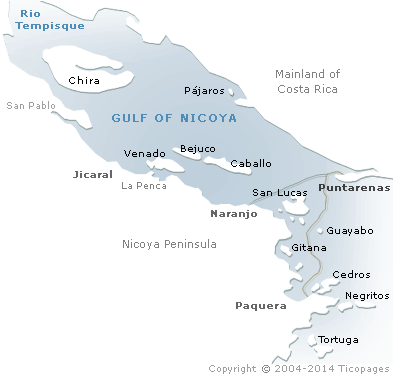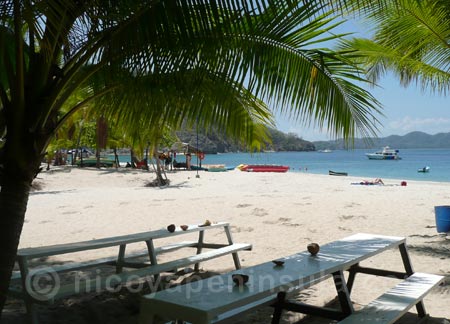Islands in the Gulf of Nicoya

Most of Costa Rica’s islands are situated in the Gulf of Nicoya. Even the larger islands are sparsely populated and touristically undeveloped. Some of them are uninhabited by humans, but are instead home to colonies of sea birds.
Tortuga Islands
With its emerald green waters and palm-fringed white sandy beaches, the Tortuga Islands are Costa Rica’s most popular island, visited by many tourists on a day trip. Located off the coast of the Curu Wildlife Refuge, the clear waters around the two islands offer excellent opportunities for snorkelling and diving. On an underwater excursion, you might spot manta rays or the sea turtles that give the island its name – Tortuga means turtle in English.

The only way to reach the Tortuga Islands is by boat. Full day tours are available from all the tourist resorts, Santa Teresa, Montezuma, Jaco, Puntarenas and even the capital, San José. The 50-minute boat ride to the islands themselves is a great experience with picturesque views of the coastline. Sometimes you can see dolphins from the boat. The tours usually include some sort of lunch and snorkelling gear.
During the day, the small beach on Tortuga Island is packed with people. Although there are no hotels on the islands, there are facilities such as toilets, a gift shop, beach bars and restaurants. After your snorkelling tour, you can rent a beach umbrella and chair to sip a tropical drink. You can also swim in the calm waters, take a banana boat ride, hire a kayak or stand-up paddleboard, or hike through the tropical forest to an island viewpoint.

Isla San Lucas
San Lucas was once a penal colony – as long as 1991. It had the reputation of being the roughest jail in Costa Rica and its 117 years history is steeped in tales of violence and hardship. A network of underground prison cells hosted society’s outcasts, who not only endured the harsh conditions but also engaged in communal activities such as fishing, farming, and domestic chores. In 2008 the island was declared a cultural heritage site and national wildlife preserve. A 40-minute boat ride from Puntarenas, San Lucas now stands as a testament to its haunting past and tours can be made to visit the prison cells with their graffiti, the church and other other buildings of the island’s grim history.
Isla Gitana
Isla Gitana protects the Bahia Gigante from rough weather, making the bay popular with boaters. On Isla Gitana, the Fantasy Island Yacht Club, was a quirky sailors hang-out until it closed in 1998.
The island’s alias, Isla Muertos, gives clue to a more remote history: indians had used it as a burial post and still you can see graves there, nowadays christianized with crosses.

Chira Island
Chira Island is the second largest island of Costa Rica (only Cocos Island is bigger). Around 3500 inhabitants live there on fishing, subsistency farming or work on the salinas, where salt is extracted from sea water. These salt pans are popular with roseate spoonbills and other wading birds. Isla Chira is bisected by a large estuary at the east leading into a canal through vast » mangrove swamps.
By now there are only few accommodations on the island. From Puntarenas a daily boat goes to Isla Chira from the fish market. You can also hire a boat from Pájaros or San Pablo.
Venado Island
Most of the 1100 inhabitants of Venado Island are huddled together in the fishing communities on the northern side, where you also find some rustic accommodations if you speak some Spanish. Hiking trails through the protected forest lead to viewpoints, other from that there isn’t much to do. Isla Venado is reached by water launch through the mangroves from "La Penca", 3 km east from Jicaral.
Isla Caballo is covered with tropical dry forest and has some nice beaches. The island is home to around 250 people, but there are no accommodations. Its smaller sister island, Isla Bejuco, is uninhabited with the exception of a caretaker having an eye on things.
Biological Reserves:

These islands are protected seabird sanctuaries and off limits for visitors. With binoculars, birdwatchers can nevertheless enjoy birdwatching from a boat.
Guayabo is the largest of four known nesting sites in Costa Rica for brown pelicans. The island also affords breeding for boobies and frigate birds and accommodates peregrine falcons in winter. The boat from Puntarenas to Paquera passes close by the cliff-bound rocky islet and you can watch the crowds of circling birds.
The Negritos Islands are neighbors of Isla Tortuga and comprise two islands separated by a narrow channel. They are covered with scrubby forest.
Pájaros island lies in front of Punta Morales, 20 km north of Puntarenas.